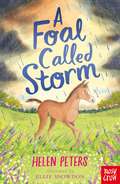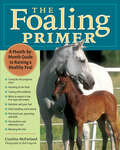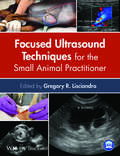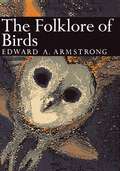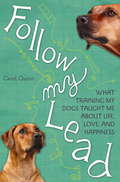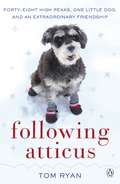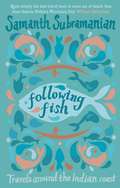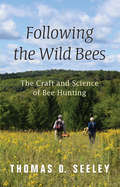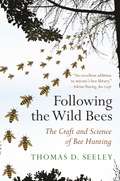- Table View
- List View
A Foal Called Storm (The Jasmine Green Series #11)
by Helen PetersJasmine's dad is a farmer, and her mum is a large-animal vet, so Jasmine spends a lot of time caring for animals and keeping them out of trouble. Unfortunately, this often means she gets into hot water herself...A perfect animal story for younger readers by Waterstones Children's Book Prize-shortlisted author Helen Peters, with beautiful black-and-white illustrations by Ellie Snowdon. When Jasmine finds a lost foal in her father's field, she can't believe her eyes. Who would abandon such a beautiful creature, especially as it's hurt its leg? With the race on to reunite Storm with his mother, Jasmine is determined to solve the mystery and bring the culprits to justice! Brilliant storytelling that will make you laugh and cry, this is Dick King-Smith for a new generation.Look out for Jasmine's other adventures!A Piglet Called TruffleA Duckling Called ButtonA Sheepdog Called SkyA Kitten Called HollyA Lamb Called LuckyA Goat Called WillowAn Otter Called PebbleAn Owl Called StarA Deer Called DottyA Donkey Called Mistletoe
The Foaling Primer: A Step-by-Step Guide to Raising a Healthy Foal
by Cynthia McFarlandStart your foal off on the right hoof! With correct handling, health care, and training during the first year, you can establish a strong foundation that will benefit your horse throughout his life. From bottle feeding to rope leading, Cynthia McFarland covers everything you need to know as you guide your foal from birth to yearling. With an emphasis on recognizing critical developmental signs, McFarland&’s expert advice will help you raise a healthy, happy, and well-adjusted foal.
Foals in the Field: Foals In The Field Ebook (Animal Ark)
by Lucy DanielsAnimal Ark is the veterinary surgery run by Mandy Hope's parents. If there are animals to be protected or looked after, Mandy is always there to help.When twin foals are born on Drysdale Farm, Mandy and James help their owner, Nick Summers. Nick is so busy building up the farm's stables, he doesn't have time to care for the sick foals. And if he isn't careful, he'll have to sell the farm, too. What will happen to the foals? Can Mandy save the day?FOALS IN THE FIELD is one of the best-loved ANIMAL ARK stories. Have you read them all?
Focus On Phytochemical Pesticides
by Martin JacobsonFirst published in 1989. Presents research and findings from a series of conferences in the 1980s on the use of plants in pesticides for insect control.
Focus On Phytochemical Pesticides
by Martin JacobsonFirst published in 1989. Presents research and findings from a series of conferences in the 1980s on the use of plants in pesticides for insect control.
Focused Ultrasound Techniques for the Small Animal Practitioner
by Gregory R. LisciandroFocused Ultrasound Techniques for the Small Animal Practitioner offers a highly practical guide to incorporating abbreviated ultrasound exams into the veterinary practice. Focused point-of-care exams are an effective way to quickly detect conditions and complications not readily apparent through the physical exam, laboratory diagnostics, or radiographic findings. Encompassing all the information needed to begin performing these techniques, Focused Ultrasound Techniques for the Small Animal Practitioner is a useful tool for improving patient outcomes in clinical practice. Covering focused exams in all body systems, the book also outlines the principles of interventional radiology, medical documentation, and the basic fundamentals of using an ultrasound machine. A companion website offers 87 video clips of AFAST, TFAST, and Vet Blue examinations with normal, abnormal, and incidental findings at www.wiley.com/go/lisciandro/ultrasound. Focused Ultrasound Techniques for the Small Animal Practitioner is an essential purchase for veterinary practitioners and specialists wanting to implement these techniques in their veterinary practice.
Focused Ultrasound Techniques for the Small Animal Practitioner
by Gregory R. LisciandroFocused Ultrasound Techniques for the Small Animal Practitioner offers a highly practical guide to incorporating abbreviated ultrasound exams into the veterinary practice. Focused point-of-care exams are an effective way to quickly detect conditions and complications not readily apparent through the physical exam, laboratory diagnostics, or radiographic findings. Encompassing all the information needed to begin performing these techniques, Focused Ultrasound Techniques for the Small Animal Practitioner is a useful tool for improving patient outcomes in clinical practice. Covering focused exams in all body systems, the book also outlines the principles of interventional radiology, medical documentation, and the basic fundamentals of using an ultrasound machine. A companion website offers 87 video clips of AFAST, TFAST, and Vet Blue examinations with normal, abnormal, and incidental findings at www.wiley.com/go/lisciandro/ultrasound. Focused Ultrasound Techniques for the Small Animal Practitioner is an essential purchase for veterinary practitioners and specialists wanting to implement these techniques in their veterinary practice.
Foinavon: The Story of the Grand National’s Biggest Upset (Wisden Sports Writing Ser.)
by David OwenIt was the upset to end all upsets. On 8 April 1967 at Aintree racecourse in Liverpool, a 100-1 outsider in peculiar blinkers sidestepped chaos extraordinary even by the Grand National's standards and won the world's toughest steeplechase. The jumps-racing establishment - and Gregory Peck, the Hollywood actor whose much-fancied horse was reduced to the status of an also-ran - took a dim view. But Foinavon, the dogged victor, and Susie, the white nanny goat who accompanied him everywhere, became instant celebrities. Within days, the traffic was being stopped for them in front of Buckingham Palace en route to an audience with the Duchess of Kent. Fan mail arrived addressed to 'Foinavon, England'. According to John Kempton, Foinavon's trainer, the 1967 race 'reminded everyone that the National was part of our heritage'. Foinavon's Grand National victory has become as much a part of British sporting folklore as the England football team's one and only World Cup win the previous year. The race has even spawned its own mythology, with the winner portrayed as a horse so useless that not even its owner or trainer could be bothered to come to Liverpool to see him run. Yet remarkably the real story of how Foinavon emerged from an obscure yard near the ancient Ridgeway to pull off one of the most talked-about victories in horseracing history has never been told. Based on original interviews with scores of people who were at Aintree on that rainswept day, or whose lives were in some way touched by the shock result, this book will use the story of this extraordinary race to explore why the Grand National holds tens of millions of people spellbound, year after year, for ten minutes on a Saturday afternoon in early spring.
Folding for the Synapse
by Andreas Wyttenbach and Vincent O'ConnorFolding for the Synapse addresses the current view on how protein folding and misfolding, controlled by molecular chaperones, contribute to synapse function and dysfunction. Molecular chaperones have been studied in relation to de novo protein folding, but there is increasing awareness that chaperone function is required for the regulation of protein dynamics when functioning physiologically as an isolated moiety or part of a protein complex. This book will introduce both important concepts of folding machineries and give examples of the biological relevance of further chaperone functions.
Folklore and Zoology
by Floe FoxonA scientific excursion into folklore, zoology, and cryptozoology, this text highlights a field, often called a pseudoscience, which seriously considers the possible existence of hidden or unknown animals not recognised in conventional zoology. Folklore and Zoology accessibly reviews the science of DNA samples; film and photograph analysis; hair and footprint examination; and the statistics behind such alleged animals as Sasquatch and the Yeti, Nessie and Champ, the Griffin and the Thunderbirds, and the possible survival of the thylacine, ivory-billed woodpecker, eastern cougar, and others. With over 400 references, Folklore and Zoology is among the most complete scientific review of cryptozoology to date, with discussion of the history and future, and successes and failures of this controversial and fascinating field, offering a fresh synthesis of a highly interdisciplinary literature. This book is ideal reading for students and academics interested in and studying zoology, palaeontology, and folklore courses.
Folklore and Zoology
by Floe FoxonA scientific excursion into folklore, zoology, and cryptozoology, this text highlights a field, often called a pseudoscience, which seriously considers the possible existence of hidden or unknown animals not recognised in conventional zoology. Folklore and Zoology accessibly reviews the science of DNA samples; film and photograph analysis; hair and footprint examination; and the statistics behind such alleged animals as Sasquatch and the Yeti, Nessie and Champ, the Griffin and the Thunderbirds, and the possible survival of the thylacine, ivory-billed woodpecker, eastern cougar, and others. With over 400 references, Folklore and Zoology is among the most complete scientific review of cryptozoology to date, with discussion of the history and future, and successes and failures of this controversial and fascinating field, offering a fresh synthesis of a highly interdisciplinary literature. This book is ideal reading for students and academics interested in and studying zoology, palaeontology, and folklore courses.
The Folklore of Birds: An Enquiry Into The Origin & Distribution Of Some Magico-religious Traditions (Collins New Naturalist Library #39)
by Edward A. ArmstrongTracing the magico-religious beliefs surrounding birds as far back in time as is possible, to the cultures in which these beliefs arose. This edition is exclusive to newnaturalists.com
Follow My Lead: What Training My Dogs Taught Me about Life, Love, and Happiness
by Carol QuinnFollow My Lead is the story of how two rambunctious dogs and a tough Eastern European dog trainer named Irina taught Carol Quinn everything she needed to know about life, love, and happiness. It all begins when the author-unhappy with her failing love affair, her career, and even herself-decides to enroll her two Rhodesian ridgebacks into dog agility training. She's hoping to both find a hobby and straighten out her unruly pets, but she soon discovers that dog agility demands more from her than she ever expected. What follows is a life-changing experience: one that teaches her not only about her dogs but also about herself. With Irina’s guidance and wisdom, Quinn and her dogs develop a deep bond of trust as they learn to navigate the course obstacles, and Quinn begins to accept her own flaws, allowing her to find the inner strength to become the "alpha dog” of her own life.
Following Atticus: How a little dog led one man on a journey of rediscovery to the top of the world
by Thomas F. RyanFollowing Atticus is Tom Ryan's moving true story, of a man and his remarkable dog.Tom Ryan is a middle-aged, overweight, no-nonsense newspaper editor. But when Atticus M. Finch, a Miniature Schnauzer, arrives, he is forced to question everything about his life. Wanting to raise money in memory of a friend who died of cancer, Tom decides that they will both climb 48 of New Hampshire's mountains during a single winter - twice.What awaits the pair is the adventure of a lifetime. In an enchanting but dangerous winter wonderland, they face raging blizzards, frostbite and storms. It is a rare test of endurance that soon becomes a soul-searching journey. And then, within a month of returning home, tragedy strikes. Atticus goes blind, and the blood tests suggest something even worse. Now facing an even greater challenge, Tom and Atticus undertake a journey through darkness and into light. For anyone that loved Marley and Me, Following Atticus by Tom Ryan is a heartwarming story of friendship, selflessness, redemption -- and above all, love.Tom Ryan worked as an editor until 2007, when he decided to sell his newspaper move to the White Mountains of New Hampshire. He started climbing in memory of a friend who died of cancer, and in the last five years has climbed an incredible four hundred and fifty 4,000-foot peaks.
Following Fish: Travels Around the Indian Coast
by Samanth SubramanianShortlisted for the André Simon Food and Drink book awardsIn a coastline as long and diverse as India's, fish inhabit the heart of many worlds - food of course, but also culture, commerce, sport, history and society. Journeying along the edges of the peninsula, Samanth Subramanian delivers a kaleidoscope of extraordinary stories.Following Fish conducts rich journalistic investigations of, among others, the use of fish to treat asthmatics in Hyderabad; of the preparation and the process of eating West Bengal's prized hilsa; of the ancient art of building fishing boats in Gujarat; of the fiery cuisine and the singular spirit of Kerala's toddy shops; of the food and the lives of Mumbai's first peoples; of the history of an old Catholic fishing community in Tamil Nadu; and of the hunt for the world's fastest fish near Goa.Pulsating with pleasure, adventure and discovery, and tempered by nostalgia and loss, Following Fish reveals a series of unknown Indias in a book as revealing of the subcontinent as any three times its length.
Following the Wild Bees: The Craft and Science of Bee Hunting
by Thomas D. SeeleyFollowing the Wild Bees is a delightful foray into the pastime of bee hunting, an exhilarating outdoor activity that used to be practiced widely but which few people know about today. Thomas Seeley, a world authority on honey bees, vividly describes the history and science behind this lost pastime and how anyone can do it. Following the Wild Bees is both a unique meditation on the pleasures of the natural world and a guide to the ingenious methods that compose the craft of the bee hunter.Seeley explains how one finds a patch of flowers humming with honey bees, captures and sumptuously feeds the bees, and then releases and follows them, step-by-step in whatever direction they fly, back to their secret residence in a hollow tree, old building, or abandoned hive. The bee hunter's reward is a thrilling encounter with nature that challenges mind and body while also giving new insights into the remarkable behavior of honey bees living in the wild.Drawing on decades of experience as a bee hunter and bee biologist, Seeley weaves informative discussions of the biology of wild honey bees with colorful historical anecdotes, personal insights, and beautiful photos. Whether you're a bee enthusiast or just curious about the natural world, Following the Wild Bees is the ideal companion for newcomers to bee hunting and a rare treat for armchair naturalists.
Following the Wild Bees: The Craft and Science of Bee Hunting
by Thomas D. SeeleyFollowing the Wild Bees is a delightful foray into the pastime of bee hunting, an exhilarating outdoor activity that used to be practiced widely but which few people know about today. Thomas Seeley, a world authority on honey bees, vividly describes the history and science behind this lost pastime and how anyone can do it. Following the Wild Bees is both a unique meditation on the pleasures of the natural world and a guide to the ingenious methods that compose the craft of the bee hunter.Seeley explains how one finds a patch of flowers humming with honey bees, captures and sumptuously feeds the bees, and then releases and follows them, step-by-step in whatever direction they fly, back to their secret residence in a hollow tree, old building, or abandoned hive. The bee hunter's reward is a thrilling encounter with nature that challenges mind and body while also giving new insights into the remarkable behavior of honey bees living in the wild.Drawing on decades of experience as a bee hunter and bee biologist, Seeley weaves informative discussions of the biology of wild honey bees with colorful historical anecdotes, personal insights, and beautiful photos. Whether you're a bee enthusiast or just curious about the natural world, Following the Wild Bees is the ideal companion for newcomers to bee hunting and a rare treat for armchair naturalists.
Following the Wild Bees: The Craft and Science of Bee Hunting
by Thomas D. SeeleyA how-to book on an exhilarating outdoor activity and a unique meditation on the pleasures of the natural worldFollowing the Wild Bees is a delightful foray into the pastime of bee hunting, an exhilarating outdoor activity that used to be practiced widely but which few people know about today. Weaving informative discussions of bee biology with colorful anecdotes, personal insights, and beautiful photos, Thomas Seeley describes the history and science behind this lost pastime and how anyone can do it. The bee hunter’s reward is a thrilling encounter with nature that challenges mind and body while also giving insights into the remarkable behavior of honey bees living in the wild. Whether you’re a bee enthusiast or just curious about the natural world, this book is the ideal companion for newcomers to bee hunting and a rare treat for armchair naturalists.
Following the Wild Bees: The Craft and Science of Bee Hunting
by Thomas D. SeeleyA how-to book on an exhilarating outdoor activity and a unique meditation on the pleasures of the natural worldFollowing the Wild Bees is a delightful foray into the pastime of bee hunting, an exhilarating outdoor activity that used to be practiced widely but which few people know about today. Weaving informative discussions of bee biology with colorful anecdotes, personal insights, and beautiful photos, Thomas Seeley describes the history and science behind this lost pastime and how anyone can do it. The bee hunter’s reward is a thrilling encounter with nature that challenges mind and body while also giving insights into the remarkable behavior of honey bees living in the wild. Whether you’re a bee enthusiast or just curious about the natural world, this book is the ideal companion for newcomers to bee hunting and a rare treat for armchair naturalists.
Follyfoot (Classic Adventures Ser. #Vol. 51)
by Monica DickensFollyfoot Farm is a retirement home for old or unwanted horses, invariably horses rescued from a cruel fate or cruel owners. It's run by the Colonel who is helped by his stepdaughter, Callie, and two stable-hands, Dora and Steve. These three youngsters have plenty to do at the stables, but can always find time to get involved in the mysteries and adventures that abound at Follyfoot.
Food and Human Responses: A Holistic View
by Kodoth Prabhakaran NairThis book discusses the role of food and the human nutrition-behavior interface. Food makes us what we are, but in addition to providing adequate nutrition, does it influence behavior? This book looks at this critical question from various angles and considers different concepts and approaches to food, nutrition and well-being. To better understand the entire gamut of the food-behavior linkage, the author unravels the workings of the mind - brain link. The book discusses this aspect and the findings add to the existing fund of knowledge in this area. Much of today’s malaise in humans can be traced to the food consumed by individuals. This book provides a comprehensive picture of the current state of human nutrition and how this can be linked to behavior.
Food and Knowledge in Renaissance Italy: Bartolomeo Scappi's Paper Kitchens
by Deborah L KrohnThough Bartolomeo Scappi's Opera (1570), the first illustrated cookbook, is well known to historians of food, up to now there has been no study of its illustrations, unique in printed books through the early seventeenth century. In Food and Knowledge in Renaissance Italy, Krohn both treats the illustrations in Scappi's cookbook as visual evidence for a lost material reality; and through the illustrations, including several newly-discovered hand-colored examples, connects Scappi's Opera with other types of late Renaissance illustrated books. What emerges from both of these approaches is a new way of thinking about the place of cookbooks in the history of knowledge. Krohn argues that with the increasing professionalization of many skills and trades, Scappi was at the vanguard of a new way of looking not just at the kitchen-as workshop or laboratory-but at the ways in which artisanal knowledge was visualized and disseminated by a range of craftsmen, from engineers to architects. The recipes in Scappi's Opera belong on the one hand to a genre of cookery books, household manuals, and courtesy books that was well established by the middle of the sixteenth century, but the illustrations suggest connections to an entirely different and emergent world of knowledge. It is through study of the illustrations that these connections are discerned, explained, and interpreted. As one of the most important cookbooks for early modern Europe, the time is ripe for a focused study of Scappi's Opera in the various contexts in which Krohn frames it: book history, antiquarianism, and visual studies.
Food and Knowledge in Renaissance Italy: Bartolomeo Scappi's Paper Kitchens (Visual Culture In Early Modernity Ser.)
by Deborah L KrohnThough Bartolomeo Scappi's Opera (1570), the first illustrated cookbook, is well known to historians of food, up to now there has been no study of its illustrations, unique in printed books through the early seventeenth century. In Food and Knowledge in Renaissance Italy, Krohn both treats the illustrations in Scappi's cookbook as visual evidence for a lost material reality; and through the illustrations, including several newly-discovered hand-colored examples, connects Scappi's Opera with other types of late Renaissance illustrated books. What emerges from both of these approaches is a new way of thinking about the place of cookbooks in the history of knowledge. Krohn argues that with the increasing professionalization of many skills and trades, Scappi was at the vanguard of a new way of looking not just at the kitchen-as workshop or laboratory-but at the ways in which artisanal knowledge was visualized and disseminated by a range of craftsmen, from engineers to architects. The recipes in Scappi's Opera belong on the one hand to a genre of cookery books, household manuals, and courtesy books that was well established by the middle of the sixteenth century, but the illustrations suggest connections to an entirely different and emergent world of knowledge. It is through study of the illustrations that these connections are discerned, explained, and interpreted. As one of the most important cookbooks for early modern Europe, the time is ripe for a focused study of Scappi's Opera in the various contexts in which Krohn frames it: book history, antiquarianism, and visual studies.
Food, Animals, and the Environment: An Ethical Approach
by Christopher Schlottmann Jeff SeboFood, Animals, and the Environment: An Ethical Approach examines some of the main impacts that agriculture has on humans, nonhumans, and the environment, as well as some of the main questions that these impacts raise for the ethics of food production, consumption, and activism. Agriculture is having a lasting effect on this planet. Some forms of agriculture are especially harmful. For example, industrial animal agriculture kills 100+ billion animals per year; consumes vast amounts of land, water, and energy; and produces vast amounts of waste, pollution, and greenhouse gas emissions. Other forms, such as local, organic, and plant-based food, have many benefits, but they also have many costs, especially at scale. These impacts raise difficult ethical questions. What do we owe animals, plants, species, and ecosystems? What do we owe people in other nations and future generations? What are the ethics of risk, uncertainty, and collective harm? What is the meaning and value of natural food in a world reshaped by human activity? What are the ethics of supporting harmful industries when less harmful alternatives are available? What are the ethics of resisting harmful industries through activism, advocacy, and philanthropy? The discussion ranges over cutting-edge topics such as effective altruism, abolition and regulation, revolution and reform, individual and structural change, single-issue and multi-issue activism, and legal and illegal activism. This unique and accessible text is ideal for teachers, students, and anyone else interested in serious examination of one of the most complex and important moral problems of our time.
Food, Animals, and the Environment: An Ethical Approach
by Christopher Schlottmann Jeff SeboFood, Animals, and the Environment: An Ethical Approach examines some of the main impacts that agriculture has on humans, nonhumans, and the environment, as well as some of the main questions that these impacts raise for the ethics of food production, consumption, and activism. Agriculture is having a lasting effect on this planet. Some forms of agriculture are especially harmful. For example, industrial animal agriculture kills 100+ billion animals per year; consumes vast amounts of land, water, and energy; and produces vast amounts of waste, pollution, and greenhouse gas emissions. Other forms, such as local, organic, and plant-based food, have many benefits, but they also have many costs, especially at scale. These impacts raise difficult ethical questions. What do we owe animals, plants, species, and ecosystems? What do we owe people in other nations and future generations? What are the ethics of risk, uncertainty, and collective harm? What is the meaning and value of natural food in a world reshaped by human activity? What are the ethics of supporting harmful industries when less harmful alternatives are available? What are the ethics of resisting harmful industries through activism, advocacy, and philanthropy? The discussion ranges over cutting-edge topics such as effective altruism, abolition and regulation, revolution and reform, individual and structural change, single-issue and multi-issue activism, and legal and illegal activism. This unique and accessible text is ideal for teachers, students, and anyone else interested in serious examination of one of the most complex and important moral problems of our time.
